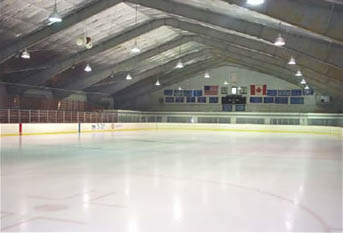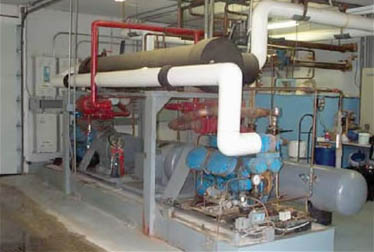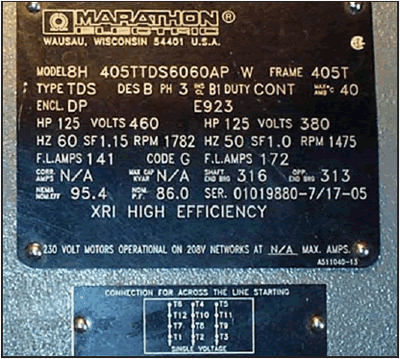
The Marthas Vineyard Arena is operated by a community- based, not-for-profit organization. What began as little more than an outdoor pond several decades ago has grown into a fully enclosed, regulation NHL-sized rink used by the islands high school hockey teams, a figure skating club, adult league hockey teams, public skaters and a handful of aspiring young Olympians ( Figure 1).
 Figure 1. Hockey teams and recreational skaters from throughout Marthas Vineyard, an island off the south coast of Massachusetts Cape Cod, use the islands regulation NHL-sized rink. High energy costs forced the arenas sponsors to take a close look at two aging compressor motors, with surprising results.
Figure 1. Hockey teams and recreational skaters from throughout Marthas Vineyard, an island off the south coast of Massachusetts Cape Cod, use the islands regulation NHL-sized rink. High energy costs forced the arenas sponsors to take a close look at two aging compressor motors, with surprising results.When the arena operators laid down their first ice in 1974, they did so using second-hand icemaking equipment: twin 53-ton refrigeration units ( Figure 2) driven by two 125- hp motors. The original motors were robust, but terribly inefficient. Today, wed refer to them as standard-efficiency motors, and the U.S. Department of Energy estimates that there are millions (in various sizes) still in use
Larry Greenberg heads up the energy subcommittee for the arenas board of trustees. (Yes, they actually have an energy subcommittee.) He explains that the arena is selfsupported and self-sufficient, and that every penny of revenue must be wisely spent. Were always looking for ways to save money, says Greenberg, Our energy costs, which had been running at $6,000 to $8,000 per month, were a natural place to start. The board of trustees has been very supportive of our committee and of the work done by our operations manager, Paul Belanger.
 Figure 2. Twin 53-ton refrigeration units, purchased as second-hand equipment in 1974, are still operating satisfactorily, but the recent retrofit of new premium-efficiency motors makes them more affordable to operate.
Figure 2. Twin 53-ton refrigeration units, purchased as second-hand equipment in 1974, are still operating satisfactorily, but the recent retrofit of new premium-efficiency motors makes them more affordable to operate.Used but Serviceable
Paul Belanger doesnt know how old the original motors were, but he had a hunch they were costing him money. The motors could have been more than 30 years old by the time we replaced them. They didnt give us much trouble and, so far as I know, they were never rewound. Still, the power they used accounted for more than 85% of our electric bill.
Belanger knew that acceptable service is good, but not if it comes at the expense of high energy costs. Electricity is expensive here on the island, where we have to import power from the mainland via undersea cables. Until recently, we were paying around 15 cents per kilowatt-hour. Utility rates have come down a few cents lately, but they still constitute the second-largest item in our budget, after salaries. An important part of my job is keeping our operating costs within budget, and when Larry and I looked at those high power costs, the compressor motors immediately came to mind.
I started to look into replacement motors and eventually called Joe Pirez at Williamson Electrical Company in Everett, Mass. Joe explained that our best option was to replace our old motors they had a rated efficiency of only 82.0% with NEMA Premium™ motors that would have an efficiency of 95.4% ( Figures 3 and 4). He showed me how the new motors would pay for themselves in just a few months, after which theyd continue to save us money, year after year.
 Figure 3. One of two premium-efficiency, 460-V, 125-hp, 1800-rpm, ODP motors that drive the arenas icemaking equipment compressors. The motors operate at 75% load, but with only a 28% duty cycle.
Figure 3. One of two premium-efficiency, 460-V, 125-hp, 1800-rpm, ODP motors that drive the arenas icemaking equipment compressors. The motors operate at 75% load, but with only a 28% duty cycle.Joe Pirez had other savings to offer, as well. Thanks to a statewide energy incentive program, he says, we were able to provide the arena with a rebate of $540 per motor. In Massachusetts, the rebates are administered by a program called MotorUp, which works with distributors like us to help our customers pick the most efficient motors for their applications. The money comes from the utilities, through a fund built up by a small charge on everyones electric bill.
 Figure 4. The dataplate for one of the new motors shows its rated efficiency to be 95.4%, meeting NEMA Premium™ standards for motors of this size. The standard-efficiency motor this unit replaced had a rated efficiency of only 82.0%, and retrofitting with the new motors generated annual energy cost savings of $9,214. The new motors paid for themselves in less than four months.
Figure 4. The dataplate for one of the new motors shows its rated efficiency to be 95.4%, meeting NEMA Premium™ standards for motors of this size. The standard-efficiency motor this unit replaced had a rated efficiency of only 82.0%, and retrofitting with the new motors generated annual energy cost savings of $9,214. The new motors paid for themselves in less than four months.The most efficient motors we sell meet or exceed NEMA Premium standards. says Pirez. These motors have rated efficiencies that are one to four percentage points higher than those for EPAct motors, the current industry standard. 1 That doesnt sound like much, but it means a great deal in terms of operating costs.
Back to TopHow Do Premium Motors Differ?
The answer lies in coppers high electrical conductivity. Premium-efficiency motors contain about 20% more copper in their windings than EPAct motors. Generally speaking, the more copper there is in a motors windings, the lower will be the resistive, or I 2R, losses, which typically account for the largest portion of a motors operating losses. In a nutshell, more copper = lower losses = higher efficiency = lower operating costs. Premium-efficiency motors typically incorporate smaller fans, improved bearings and lubricants, and are machined to tighter tolerances. All these steps contribute to higher efficiency. They also tend to run cooler, which can mean longer life. The 125-hp motors installed on the Marthas Vineyard Arena compressors operate on a 28% duty cycle; that is, theyre running only a little more than a quarter of the time. In fact, both compressors only operate during startup, and only one is needed to keep the rink operating. Ordinarily, a duty cycle as low as that wouldnt leave much room for savings, but the new motors offered quite high efficiencies, and the old motors they replaced were very inefficient. That difference, plus the high local utility rates, generated enough savings to enable the motors to pay for themselves very quickly.
Back to TopShort Payback Period
How quickly? Before replacing their compressor motors, the arena used 213,224 kWh and spent $31,984 to operate each compressor motor for a year
( Table 1).Operating at the same 75% load factor and 28% duty cycle, each new motor used 182,509 kWh and cost only $27,376 to operate. That amounts to a total annual savings, for both motors combined, of 61,430 kWh in energy and $9,214 in cold, hard cash.
The new motors cost $1,908 apiece after the dealers normal discount, less the $540 rebate from the MotorUp program. Installation added $140 per motor, and there was no scrap allowance for the old units.
| Comparison Data | Existing Motor (replaced) | NEMA Premium™ Motor |
|---|---|---|
| Average Standard Efficiency | Marathon 405TTDS6060 | |
| Size | 125 hp | 125 hp |
| Speed | 1800 rpm | 1800 rpm |
| Enclosure | ODP | ODP |
| Voltage | 460 V | 460 V |
| Duty Cycle, hours use/year | 28%, 2500 h/y | 28%, 2500 h/y |
| Load | 75.0% | 75.0% |
| Efficiency | 82.0% | 95.4% |
| Purchase Price | $1,908 | |
| Installation Cost | $140 | |
| Motor Rebate | $540 | |
| Savings per Motor | ||
| Energy Use | 213,224 | 182,509 |
| Energy Cost | $31,984 | $27,376 |
| Energy Savings | 30,715 kWh | |
| Annual Energy Cost Savings | $4,607 | |
| Simple Payback | 0.33 years | |
Applying these costs against the $4,607 in savings for each motor means that the new premium-efficiency motors paid for themselves (simple payback) in 0.33 years, or about four months! Thats equivalent to a 240% return on investment. If the rebate is not factored in, the payback is still less than six months. 2
Paul Belanger has put the savings to good use. He used some of his first-year gains to buy two new electronic starters. Even if that expense is counted as part of the motor replacement costs, his payback is still well under one year. Some of the savings will pay for other energy-saving devices, like a state-of-the-art ice temperature sensor and a variable speed drive on a fan motor. Call it Yankee thriftiness if you will, but Larry Greenberg knows such measures can have important benefits for a small organization. Were a small community, and its important for us to keep the arena open as much as possible. Keeping our costs down lets us do that, and its given us some unexpected payoffs. With plenty of ice time available for practice, our high school hockey team has managed to win two Division III state championships!
Were not surprised. Copper and high energy efficiency are always on the winning side.
Back to TopThe Principals
 Paul Belanger, a veteran refrigeration technician, has served as operations manager for Marthas Vineyard Arena, Inc., for 15 years. The associations Web site is www.mvarena.com. Mr. Belanger can be reached at 508- 693-5329, [email protected].
Paul Belanger, a veteran refrigeration technician, has served as operations manager for Marthas Vineyard Arena, Inc., for 15 years. The associations Web site is www.mvarena.com. Mr. Belanger can be reached at 508- 693-5329, [email protected]. Located in Springfield, Massachusetts, the MotorUp Premium-Efficiency Motor Initiative offers end-user training and presentations, plus dealer support, through its field representative network in New England and portions of New York and New Jersey. The initiative provides cash rebates of $45 to $700 each for motors that meet NEMA Premium efficiency standards for qualified customers located within certain utility service areas. For further information, call 888-456-6867, Fax 413-734-3475.
Located in Springfield, Massachusetts, the MotorUp Premium-Efficiency Motor Initiative offers end-user training and presentations, plus dealer support, through its field representative network in New England and portions of New York and New Jersey. The initiative provides cash rebates of $45 to $700 each for motors that meet NEMA Premium efficiency standards for qualified customers located within certain utility service areas. For further information, call 888-456-6867, Fax 413-734-3475.- Joe Pirez is a sales representative for Williamson Electrical Company, New England's largest electrical distributor. Mr. Pirez is located in the company's Everett, Massachusetts, offices and can be reached at 617-884-9200, [email protected].
Footnotes
-
 "EPAct" stands for the Energy Policy Act of 1992, a federal law that, among other things, sets minimum efficiency standards for certain types of motors sold in the USA after October 24, 1997, the date the law became effective. "EPAct motors" are those that meet these standards.
"EPAct" stands for the Energy Policy Act of 1992, a federal law that, among other things, sets minimum efficiency standards for certain types of motors sold in the USA after October 24, 1997, the date the law became effective. "EPAct motors" are those that meet these standards. -
 Premium-efficiency motors may have characteristics different from standard- or EPAct-efficiency motors, such as starting current, torque, speed, etc. All engineering parameters must be taken into account when considering replacement.
Premium-efficiency motors may have characteristics different from standard- or EPAct-efficiency motors, such as starting current, torque, speed, etc. All engineering parameters must be taken into account when considering replacement.
